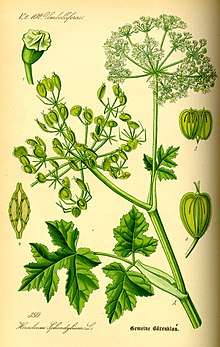Heracleum persicum
Heracleum persicum, commonly known as Persian hogweed or simply hogweed,Golparگلپر , is a polycarpic perennial herbaceous flowering plant in the carrot family Apiaceae, originally native to the region of Iran (Persia). It grows wild in humid mountainous regions in Iran, as well in some adjacent areas. As a spice, its common name in English is 'angelica,' although it is not related to the genus Angelica.[1] Having been introduced in the 1830s, it has spread across Scandinavia. It is now very common in northern Norway, where it is known as the Tromsø palm.[2] The plant has also been spotted in Sweden.[3] In Finland, it has been declared as invasive species.[4]
| Golpar | |
|---|---|
 | |
| Flower and leaf | |
| Scientific classification | |
| Kingdom: | |
| (unranked): | |
| (unranked): | |
| (unranked): | |
| Order: | |
| Family: | |
| Genus: | |
| Species: | H. persicum |
| Binomial name | |
| Heracleum persicum | |

Persian hogweed is a polycarpic perennial,[5][6] that is, a mature plant flowers and bears fruit season after season.
Uses
Food uses
The seeds are used as a spice in Persian cooking. The very thin, small seed pods are aromatic and slightly bitter. They are usually sold in powdered form and are often erroneously sold as "angelica seeds". The powder is sprinkled over broad beans, lentils and other legumes, and potatoes. Golpar is also used in soups and stews. It is often used sprinkled over pomegranate arils.[7] Golpar is also mixed with vinegar into which broad beans are dipped before eating.
Golpar can be used in small amounts (1 or 2 tsp per pound) when cooking beans to reduce the effect of gas in the digestive tract associated with consuming beans.[8]

In Persian cuisine, the petals are used in the spice mixture advieh to flavor rice dishes, as well as in chicken, Fish and bean dishes.
The tender leaves and leaf stalks can also be pickled (known as golpar torshi).
Public health and safety
The sap of the Tromsø palm contains furanocoumarins, which in combination with ultraviolet light, leads to phytophotodermatitis.[6] There is some anecdotal evidence that H. persicum may be less dangerous than H. mantegazzianum with respect to phototoxicity.[1]
Control measures
Known ways to fight Tromsø palm are the constant cutting of new shoots. When cutting down, protective equipment is recommended, and metal cutting tools should be cleaned after use because the juice is oxidizing.
See also
- Heracleum, the genus
- Other tall invasive Heracleum species: Heracleum mantegazzianum and Heracleum sosnowskyi
- Non-invasive Heracleum species: Heracleum sphondylium and Heracleum maximum
- Species that can be mistaken for Heracleum persicum:[5] wild parsnip, garden angelica, wild angelica
References
Kousha, Armin; Ringø, Einar. 2015. Antibacterial Effect of Aquatic Extract of Heracleum Spp. Hogweed Plants from Europe on Thirteen Different Bacteria. Pharmaceutical Chemistry Journal 2015 ;Volum 48.(10) s. 675-678. DOI:10.1007/s11094-015-1169-0
- Alm, Torbjørn (2013). "Ethnobotany of Heracleum persicum Desf. ex Fisch., an invasive species in Norway, or how plant names, uses, and other traditions evolve". Journal of Ethnobiology and Ethnomedicine. 9 (1): 42. doi:10.1186/1746-4269-9-42. ISSN 1746-4269. PMC 3699400. PMID 23800181.
- Straumsheim Grønli, Kristin (July 10, 2006), Bjørnekjeks tar kvelertak på naturen (Hogweed takes stranglehold on nature), archived from the original on 2011-09-23, retrieved September 12, 2011
- "Heracleum mantegazzianum, Heracleum sosnowskyi and Heracleum persicum". EPPO Bulletin. 39 (3): 489–499. 2009. doi:10.1111/j.1365-2338.2009.02313.x.
- "Jättiputket (Heracleum persicum -ryhmä) - Vieraslajit.fi". vieraslajit.fi.
- Booy, Olaf; Cock, Matthew; Eckstein, Lutz; Hansen, Steen Ole; Hattendorf, Jan; Hüls, Jörg; Jahodová, Sárka; Krinke, Lucás; Marovoková, Lanka; Müllerová, Jana; Nentwig, Wolfgang; Nielsen, Charlotte; Otte, Annette; Pergl, Jan; Perglová, Irena; Priekule, Ilze; Pusek, Petr; Ravn, Hans Peter; Thiele, Jan; Trybush, Sviatlana; Wittenberg, Rüdiger (2005). The giant hogweed best practice manual: guidelines for the management and control of invasive weeds in Europe (PDF). Hørsholm: Center for Skov, Landskab og Planlægning/Københavns Universitet. ISBN 978-87-7903-209-5. Retrieved September 1, 2018.
- Meier, Sophie; Taff, Gregory N.; Aune, Jens B.; Eiter, Sebastian (2017). "Regulation of the Invasive Plant Heracleum persicum by Private Landowners in Tromsø, Norway". Invasive Plant Science and Management. 10 (2): 166–179. doi:10.1017/inp.2017.11.
- Fujimori, Sachi (December 12, 2013). "Get cooking with pomegranates, the super fruit that's in season". NorthJersey.com. Retrieved December 31, 2013.
- "Gas in the Digestive Tract: Digestive Diseases - NIDDK". Archived from the original on 2014-10-11. Retrieved 2010-11-08.
External links
- Analysis of the Oil of Heracleum persicum L. (seeds and stems)
- Heracleum persicum, Heracleum glabrescens (in Persian)
- Sajjadi, S. E.; Noroozi, P. (2007). "Isolation and identification of xanthotoxin (8-methoxypsoralen) from the fruits of Heracleum persicum Desf. ex Fischer". Research in Pharmaceutical Sciences. April 2007 (2): 13–16. Retrieved 15 June 2016.